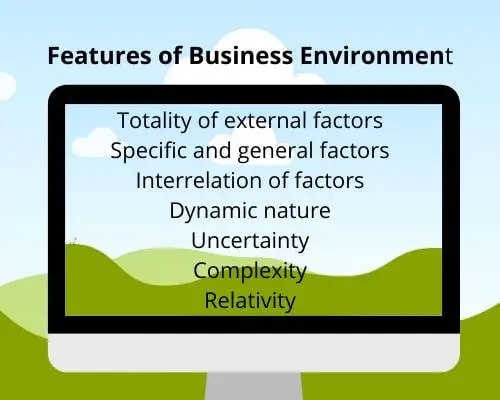Business environment is the collection of internal and external factors that affect activities and influence how a business organization is operated. The business environment comprises different components, factors, and features. In this article, we will discuss the features of the business environment.
Business features describe the forces that directly or indirectly play a role in the development and execution of the goals of an organization. The significant features of the business environment are-
- The totality of external factors
- Specific and general factors
- Interrelation of factors
- Dynamic nature
- Uncertainty
- Complexity
- Relativity
To understand the above-mentioned features, we are going to describe them in simple words and try to clarify them with examples.

The totality of external factors: Micro and macro external factors related to a business include customers, suppliers, competitors, and stakeholders as well as environmental issues, government policies, etc. Everything outside that organization added up forms a basic business environment. For example, if Samsung is to launch in a country, the business environment will include the other mobile brands, the demographics of the consumers, and everything else combined.
Specific and general factors: Specific factors are those that have a direct impact on the organization. Such factors can be customers, intended market, competitors, suppliers, etc.
On the contrary, general factors are the ones that indirectly affect functionality. Their existence doesn’t rely on the business itself. Political, legal, social, and technological situations would be good examples of this.
If we think about any food chain like McDonald’s, the culture and food of a country will be a part of the general factors. Specific factors will be their target customer group or the number of staff countrywide.
Interrelation of factors: All the factors are connected to each other. The performance of one affects the performance of others. A change in one factor makes the other factors adapt to the change and react accordingly. Mutual interdependence always prevails.
If the production of an IT company needs to grow, there will be a need for newer employees and new plans to keep the organization going.
Dynamic Nature: The business environment keeps changing continuously. There are newer demands, newer trends, and newer competitions. The chances for innovation are endless. Then there are external effects like politics and policy change. These come with opportunities and challenges. The ever so changing environment demands prompt action for the welfare of the organization.
Minnesota Mining and Manufacturing Company initially started with one product but they changed with the changing environment, adding waterproof sandpaper, adhesive cellophane tape, masking tape, and desktop photocopiers, among other goods. Now their most known product is scotch tape.
Uncertainty: Business deals with uncertainty on a regular basis. There is a vast range of factors at play and the dynamic business environment is almost always uncertain. Future uncertainty makes it hard to predict. Changes in general factors are often quite abrupt and unavoidable. Continuous evaluation and innovation are prime requirements.
For example, in the wake of the industrial revolution, many organizations are facing problems in deciding their next possible step that would retain their success.
Complexity: The preceding factors create an interconnected structure that’s very hard to understand and evaluate. The smallest factors can have big impacts and the path to that can be very complicated. The business environment may include requirements of negotiations and partnerships in crucial moments.
For example, the general factors being a deciding factor in the case of consumer and producer surplus is a complex scenario and involves multiple layers of consideration.
Relativity: The business environment can differ in terms of geographic location, culture and other factors. The impacts of the factors can also be different for different businesses.
For instance, a power shortage will not affect a restaurant as badly it will affect an information technology-related company. The degree to which the factors are able to influence the organization depends on the size of the organization, the type of business they are involved in, and what they expect to achieve.
Understanding the features of a business environment gives the organization an upper hand in taking decisions related to opportunities available. Not only that, but a proper analysis of the situation of the features also helps understand the scope of proper utilization of resources and workforce. This eventually leads to a simplified and efficient strategy formulation for the business to progress.
